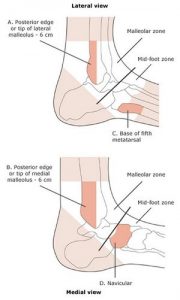++ANKLE SPRAINS++
Ankle injuries are one of the most common presentations to our clinic whether on the sporting field, a simple trip on a step or a boozy Michael Jackson dance move. Although they are a common injury they tend to be poorly managed and therefore have a high rate of re-occurrence. We all have that friend that must strap or brace their ankle for any task that may involve uneven ground.
The most common mechanism causing ankle sprains can be seen below. The foot generally twists out to the side and the ligament is taken to full stretch, this force continues to eventually cause disruption to the ligament.
How do I know I have sprained ankle and not broken my ankle?
Ask yourself these questions?
- Can I walk on it?
- Does it hurt to touch these 4 spots pictured?

- Look at it and see if it has A LOT of swelling?
- Is your foot giving you pain at night time?
- Did you hear a CRACK at the time of the injury?
If you answered YES!
Get an x-ray to confirm you do not have a fracture prior to seeing a Physio 🙂
Signs and Symptoms of an Ankle Sprain?
– Bruising + swelling
– Pain
– Inability to walk normally
– Difficulty pulling the foot back towards the shin
– Tenderness over the out aspect of the foot
– Reduced ability to balance
Great. I have a sprained ankle what to do now?
Follow these basic principals for ankle injury rehab!
- GET THAT SWELLING DOWN
– Move the foot as soon as you can with ankle pumps (moving foot up and down).
– Compress the foot with taping.
– Ice.
– Start calf raises in some way shape or form as pain permits. - MOVE
– Keep the foot moving as soon as you can to help pump that swelling out.
– Begin strengthening the calf complex as pain allows.
– Restore normal walking pattern.
– Slowly build muscle capacity up around the foot and ankle. - GET RANGE BACK
– Swelling after an injury can make the ankle stiff especially into dorsiflexion (bringing your knee over your toe in standing).
– In most cases with a few exceptions this needs to be addressed immediately.
– Calf stretches and ankle movements regularly throughout the day.
– Physiotherapy techniques including joint mobilisation, soft tissue work and dry needling. - BALANCE
– Start re-training balance as soon as you can.
– If you don’t use it you lose it so start with simple strategies in safe positions as soon as possible.
Ensure to get assessed by a Physio as there will be different rehab protocols for different types of ligaments, grades of injury and injury location.
Ankle injuries are not just a simple ankle sprain. A simple ankle injury will need 3 months re-training practice as a bare minimum to restore full function and prevent any re-occurrence. If you stick to MOVE, GET RANGE BACK and BALANCE your most of the way there and seek guidance from a good Physio!
Written by Pat Lincoln
(Director and Physiotherapist at The Physio Depot)



